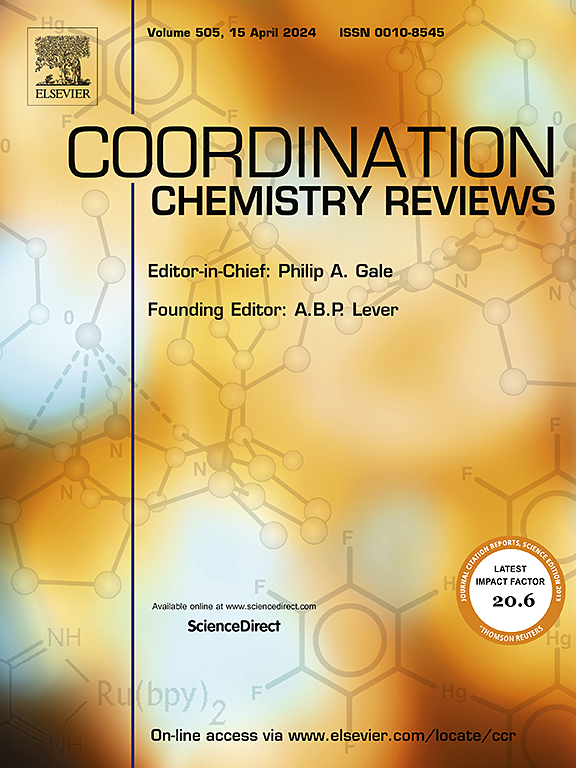有机铈(IV)包括茂金属-、烃基-、卡宾-、亚胺-和氧-配合物及相关化合物:对键、电子结构和反应性趋势的新见解
IF 23.5
1区 化学
Q1 CHEMISTRY, INORGANIC & NUCLEAR
引用次数: 0
摘要
由于其易接近的氧化还原偶和稀有气体电子构型,铈(IV)在分子体系中的研究越来越多,以探索f元素键、4f/5d共价和多构型电子结构的基本问题。在这篇综述中,我们研究了具有直接CeC、CeN和CeO键的分子Ce(IV)配合物的最新进展。本文描述了用于合成和分离CeC、CeN和CeO键配合物的合成策略,它们的反应性分布,以及这些物质的结构、光谱、电化学和磁性特征。所调查的文献强调了支持配体设计对于实现含有反应性供体配体的Ce(IV)体系的动力学和热力学稳定的重要性。所描述的许多Ce(IV)体系有助于越来越多的证据表明4f轨道参与ceiv配体成键。本文所描述的结果有望作为进一步探索f嵌段化合物中难以捉摸的键基序的基础,并将有助于指导未来铈基配合物的设计,从而为改进镧系元素分离技术、催化剂和材料性能的发展提供信息。本文章由计算机程序翻译,如有差异,请以英文原文为准。
Organo-cerium(IV) species comprising metallocene-, hydrocarbyl-, carbene-, imido-, and oxo-complexes and related compounds: Emerging insights into bonding, electronic structures, and reactivity trends
Owing to its accessible redox couple and noble gas electronic configuration, cerium(IV) has increasingly been studied in molecular systems to probe fundamental questions of f-element bonding, 4f/5d covalency, and multi-configurational electronic structure. In this review, we examine recent developments in molecular Ce(IV) complexes featuring direct Ce![]() C, Ce
C, Ce![]() N, and Ce
N, and Ce![]() O bonds. The synthetic strategies used to synthesize and isolate complexes with Ce
O bonds. The synthetic strategies used to synthesize and isolate complexes with Ce![]() C, Ce
C, Ce![]() N, and Ce
N, and Ce![]() O linkages, their reactivity profiles, and the structural, spectroscopic, electrochemical, and magnetic features of these species are described. The surveyed literature underscores the importance of supporting ligand design for achieving kinetic and thermodynamic stabilization of Ce(IV) systems containing reactive donor ligands. Many of the Ce(IV) systems described contribute to the growing body of evidence of 4f orbital participation in CeIV–ligand bonding. The results described herein are expected to serve as a foundation for further exploration of elusive bonding motifs in f-block compounds and will help guide the design of future cerium-based complexes that can inform the development of improved lanthanide separation technologies, catalysts, and materials properties.
O linkages, their reactivity profiles, and the structural, spectroscopic, electrochemical, and magnetic features of these species are described. The surveyed literature underscores the importance of supporting ligand design for achieving kinetic and thermodynamic stabilization of Ce(IV) systems containing reactive donor ligands. Many of the Ce(IV) systems described contribute to the growing body of evidence of 4f orbital participation in CeIV–ligand bonding. The results described herein are expected to serve as a foundation for further exploration of elusive bonding motifs in f-block compounds and will help guide the design of future cerium-based complexes that can inform the development of improved lanthanide separation technologies, catalysts, and materials properties.
求助全文
通过发布文献求助,成功后即可免费获取论文全文。
去求助
来源期刊

Coordination Chemistry Reviews
化学-无机化学与核化学
CiteScore
34.30
自引率
5.30%
发文量
457
审稿时长
54 days
期刊介绍:
Coordination Chemistry Reviews offers rapid publication of review articles on current and significant topics in coordination chemistry, encompassing organometallic, supramolecular, theoretical, and bioinorganic chemistry. It also covers catalysis, materials chemistry, and metal-organic frameworks from a coordination chemistry perspective. Reviews summarize recent developments or discuss specific techniques, welcoming contributions from both established and emerging researchers.
The journal releases special issues on timely subjects, including those featuring contributions from specific regions or conferences. Occasional full-length book articles are also featured. Additionally, special volumes cover annual reviews of main group chemistry, transition metal group chemistry, and organometallic chemistry. These comprehensive reviews are vital resources for those engaged in coordination chemistry, further establishing Coordination Chemistry Reviews as a hub for insightful surveys in inorganic and physical inorganic chemistry.
 求助内容:
求助内容: 应助结果提醒方式:
应助结果提醒方式:


